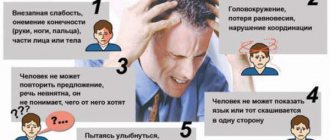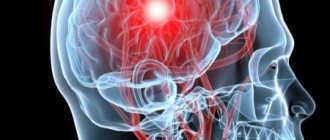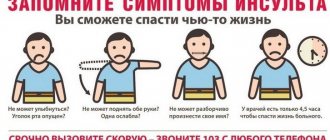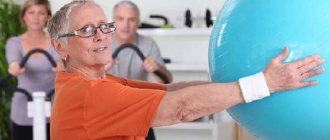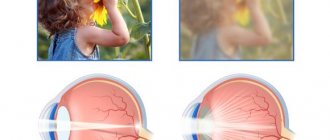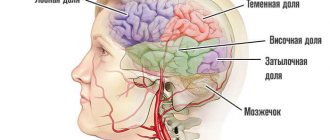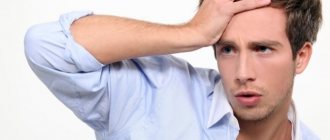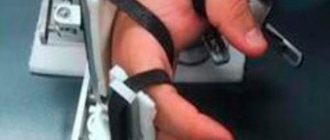Pinchuk Elena Anatolyevna
Deputy chief physician for medical work, kmn, neurologist, doctor of physical and rehabilitation medicine
Kritskaya Olga Pavlovna
Neurologist, highest category
Maltseva Marina Arnoldovna
Neurologist, specialist in the field of extrapyramidal pathologies, doctor of the highest category
Shabunina Ekaterina Mikhailovna
Neurologist, category 2
The term stroke is understood as an acute disorder of cerebral circulation with a persistent decrease or complete loss of certain body functions. A stroke can be a focal stroke (micro-stroke) or extensive, in which paresis can occur, most often of one half of the body. A condition in which a person experiences weakness or complete lack of movement in the left or right half of the body is called hemiparesis. Paralysis of the left side or paralysis of the right side during a stroke often occurs as a result of rupture of a cerebral artery, if qualified help is not sought in a timely manner.
Features and symptoms
The human brain has such a feature that the left hemisphere of the brain is responsible for the right side of the body and, conversely, the right side of the brain is responsible for the left half of the body. Therefore, when a stroke occurs in the left hemisphere of the brain, the right side of the patient’s body is affected. Another feature of this disease is that this stroke occurs many times more often than right-sided. Symptoms of the disease include:
- headache, often of a sharp nature;
- nausea, even vomiting is possible;
- breathing rhythm disturbance;
- deterioration of coordination;
- excessive sweating;
- loss of consciousness;
- incoherent speech, sometimes the ability to speak is completely lost;
- lethargy;
- hearing impairment;
- the right side of the face is distorted (the corners of the mouth and eyes are lowered);
- paralysis of the right eye, numbness of the right side of the face;
- paralysis of the entire right half of the body, most often only partial paralysis, for example, only the arms or legs;
- rarely, but disruption of the functioning of internal organs located on the right or in the center may occur;
- the person does not perceive colors, letters and numbers, possibly aggressive or even inappropriate behavior.
It’s worth noting right away that all the symptoms from the list above almost never occur simultaneously. It is usually a combination of 2-8 symptoms, depending on the severity of the stroke, the person's age and other conditions. In any case, even with the slightest hint of a stroke, it is necessary to call an ambulance. Then the chances of preventing a stroke and maintaining a person’s capacity increase significantly.
What is included in treatment and rehabilitation
The treatment regimen for stroke on the left includes the use of medications, urgent surgery (hematoma removal, decompression, thrombolysis, drainage), physiotherapy, exercise therapy, massage, oxygen therapy, complete rest, constant monitoring of vital signs (pulse, respiratory rate, pressure), refusal from bad habits, proper nutrition, treatment of existing pathologies (hypertension, atherosclerosis, heart rhythm disturbances).
Taking medications
For cerebral hemorrhage the following are used:
hemostatics (Vikasol);
- antihypertensive drugs (Captopril, Enalapril, beta-blockers);
- diuretics (Lasix, Torasemide, Diuver, Trigrim, Furosemide);
- sodium chloride solution;
- symptomatic drugs (antiemetics, analgesics, anticonvulsants);
- calcium channel blockers (Nimodipin-Nativ);
- antioxidants (Mildronat, Mexidol);
- ascorbic acid;
- calcium preparations;
- corticosteroids (Dexamethasone).
Treatment of ischemic stroke differs in that it uses statins (for atherosclerosis), antiplatelet agents and anticoagulants (Thrombo Ass, Aspirin, Clopidogrel, Warfarin), angioprotectors (Vazonit, Pentoxifylline, Trental), B vitamins, thrombolytics (Streptokinase, Thromboflux) and neuroprotectors ( Cavinton, Vinpocetine, Mexidol, Glycine, Lucetam, Nootropil, Piracetam, Cerebrolysin, Semax, Omaron).
Stroke Physiotherapy
For a stroke, the following can be done:
- magnetic therapy;
- exposure to vibration;
- acupuncture.
Exercise therapy and breathing exercises
Physical therapy is useful during the rehabilitation phase after the symptoms of the disease have subsided. It helps normalize muscle tone, improve blood flow, and reduce blood stagnation. Squeezing your arms, raising them in front of you, and raising and lowering your legs while lying down are helpful.
Breathing exercises are beneficial for the functioning of the heart and lungs. You can inflate balloons, hold your breath, or blow air through a straw.
Combating complications
If the left side is paralyzed after a stroke and there are complications, you may need:
- taking antibiotics (for pneumonia and sepsis);
- classes with a speech therapist (for speech disorders);
- massage;
- use of heart medications;
- wound healing, use of powders and creams, local antiseptics, dressing (for bedsores).
Lifestyle change
After a stroke it is recommended:
- relax more often in sanatoriums and resorts;
- move more;
- limit physical activity (do not lift heavy objects);
- eliminate stressful situations;
- listen to calm music;
- quit smoking and alcohol;
- walk in the fresh air more often;
- eat more fruits, berries and vegetables;
- limit the consumption of sweets, pickles, fatty foods and baked goods (for atherosclerosis);
- do not overeat;
- control your weight.
Which case is more dangerous: right-sided or left-sided
Any stroke, no matter which half of the brain, is dangerous. Because of this disease, a person may remain disabled for life. But a left-sided stroke is much easier to recognize, so people with this disease quickly seek professional help, which means the chances of saving a person’s capacity are higher. A right-sided stroke is more difficult to recognize, so people often seek help late, when a large number of brain cells have already died.
Features of the treatment of left-sided strokes
As soon as a person is admitted to the hospital, he will be immediately connected to life support systems and all vital signs will be monitored. After this, they will begin to fight the stroke itself, and the actions of doctors depend on the type of disease: ischemic or hemorrhagic. In some situations, surgery may be required, for example to dissolve a blood clot. After this, the patient will be left in the hospital under the supervision of specialists, and will also be prescribed a course of medications, depending on the type of stroke and severity.
Help with paralysis
At first, the patient is bedridden and should not make sudden movements. After the initial drug therapy has been completed, development of the paralyzed side begins. At this time, the attending physician monitors the patient’s body parameters, adjusts his diet, and develops a set of simple exercises that will reanimate motor functions and restore sensitivity and mobility to the limbs.
It will take a long time to recover fully or to the maximum possible level, so loved ones must be ready to provide care and a positive attitude to the patient. After all, only optimistic energy, smiles and joyful events can set the patient up for quick rehabilitation and a fulfilling life.
Complications and prognosis after left hemisphere stroke
The complication and prognosis of a left hemisphere stroke directly depend on how quickly first aid was provided. Equally important is the professionalism of the attending physician and the effectiveness of the treatment that will be provided. In general, complications can spread only to those functions and parts of the body for which the left half of the brain is responsible. Let's take a closer look at complications after a left hemisphere stroke.
Speech impairment and decreased vision
Speech impairment and decreased vision occur most often during and after a stroke on the left side. This is due to the fact that the left hemisphere coordinates these functions of the human body. Moreover, the left eye suffers several times less than the right (but vision decreases in both eyes). A person can restore both functions if medical care was provided quickly. But if decreased vision can be corrected surgically or with glasses, then restoring clarity of speech is currently very problematic.
Articulation disorders and paralysis
Paralysis often occurs in the lower right limb, less often in the arm, and even more rarely in the organs. If the paralysis does not go away within a few days after the stroke, then it is hardly possible to talk about a complete recovery. If paralysis of internal organs occurs, death is likely (not immediately, but within 2-3 days). True, if a person is connected to a life support machine, then the death outcome can be postponed.
Decrease and loss of memory
Decrease and loss of memory are a consequence characteristic of a stroke on the right side of the brain. In our situation, memory problems occur extremely rarely, and if they occur, they are minor. For example, a person may completely forget the day he had a stroke. This often happens with right-sided disease, but sometimes occurs with left-sided disease.
Correction of movement disorders
Treatment for paralysis of the left side of the body after a stroke includes exercise therapy, massage, and physiotherapeutic procedures. It is necessary to start performing these activities as early as possible. Of course, taking into account the patient's condition.
In the first days after a stroke, bed rest is required. It is important to take measures to prevent bedsores and the occurrence of congestion in the vessels of paralyzed limbs. The patient should not remain in one position for a long time. It is important that he lies not only on the healthy side, but also on the paralyzed side. The affected limbs should be placed in the correct position. This is done to prevent compression of blood vessels and nerves, as well as to prevent the development of contractures. Central paralysis is characterized by muscle hypertonicity, which must be treated, otherwise the prognosis for the return of motor functions will be unfavorable.
Treatment by position:
- Lying on your back. The left hand is taken to the side, extended, fingers spread. The position of the left leg is different: the limb is slightly bent at the knee, the foot is at a right angle in relation to the shin.
- On the healthy side. The arm is bent at the elbow and shoulder joints, the leg at the hip and knee. Pillows are placed under the limbs.
Giving the patient a special position in bed
- On the side of paralysis. Position of the left arm: extended forward, extended. The left leg is slightly bent at the knee.
The correct position of the patient in bed should be constantly monitored and changed every 2 hours
In case of severe spasticity, treatment with muscle relaxants (Mydocalm, Sirdalud, botulinum toxin) is prescribed.
Paralysis of the left side is also corrected with the help of exercise therapy and massage. You should start with passive gymnastics, when all the movements are made not by the patient, but by the instructor. Later, when the patient regains the ability to move, he needs to be encouraged to perform independent exercises.
Treatment of paralysis of the left side of the body after a stroke involves teaching the patient movement and self-care skills. They usually start gradually. First, the patient is taught to sit up in bed, then to stand up, and only then to walk.
Restoration of movement of the limbs on the left side occurs unevenly. It is difficult to restore fine motor skills and it is not always possible to achieve the previous volume and dexterity of movements. After a stroke, it is necessary for the patient to do special exercises with his left hand: assemble mosaics, puzzles; fingered small objects.
Sensorimotor simulator for rehabilitation after stroke
Massage is another important component, without which treatment of the consequences of stroke will be ineffective. It improves blood flow in paralyzed limbs and reduces muscle tone, which is very important for the prevention of contractures.
The main methods of treatment for paralysis or paresis are exercise therapy, massage, physiotherapy (magnetic therapy, ozokerite, electrophoresis, electrical stimulation, biomechanics).
Mental disorders
Often there are not only physical disorders, but also mental ones. As mentioned above, the left side of the brain is responsible for logical thinking. Naturally, with a left-sided stroke, a person’s logic is disrupted, which is why one can observe aggressive and strange human behavior. And this is precisely what mental disorders are associated with, which often manifest themselves in consequences.
Lack of control over natural processes
With a complex and advanced stroke, there may be a lack of control of natural processes. This means that a person walks under himself and cannot do anything about it. In this case, only diapers and a urinary catheter will help. In order not to aggravate a person’s mental health, there is no need to express complaints about this, since the patient cannot control this process. In this difficult situation, the patient needs the support and understanding of loved ones.
Coma and death
Coma occurs if the victim has not received medical care for a long time. Death is the worst case scenario, occurring in 28% of left-sided strokes. To avoid both options, you need to call an ambulance as quickly as possible. The rest depends on the professionalism of the doctors, the age of the patient and the type of stroke.
Epilepsy
Epilepsy is a seizure disorder that occurs at any time. After a left-sided stroke, the right side of the body is susceptible to seizures. Epilepsy most often occurs in the upper limb, but can also occur in the leg. If a patient periodically exhibits signs of epilepsy, it is imperative to tell the doctor about this so that the latter can adjust the treatment.
Rehabilitation period
The rehabilitation period lasts a long time, usually several months. First, the consequences of a stroke are eliminated, then the patient and his relatives are advised about preventing relapse. For example, it is necessary to follow the principles of a healthy lifestyle, go on a special therapeutic diet, normalize the daily routine, give up cigarettes and alcohol, and also take medications prescribed by a doctor.
How long do they live after a stroke on the left side?
After a stroke, a person can live to a ripe old age and die of natural causes. Other people die within a few days or a week from the effects. Therefore, it is impossible to give even an approximate answer to this question. This depends on many factors: age, degree of brain damage, how quickly and professionally medical care was provided, and so on.
Diet at home
Rehabilitation at home involves observing certain dietary habits. The emphasis is on healthy, balanced foods rich in essential vitamins and microelements. Preference is given to dairy and fermented milk products, vegetables and fruits, and porridges steamed in water. Later, you can diversify your diet with lean boiled meat and poultry, and add steamed fish. In case of weak immunity, ascorbic acid or a complex of vitamins is prescribed.
